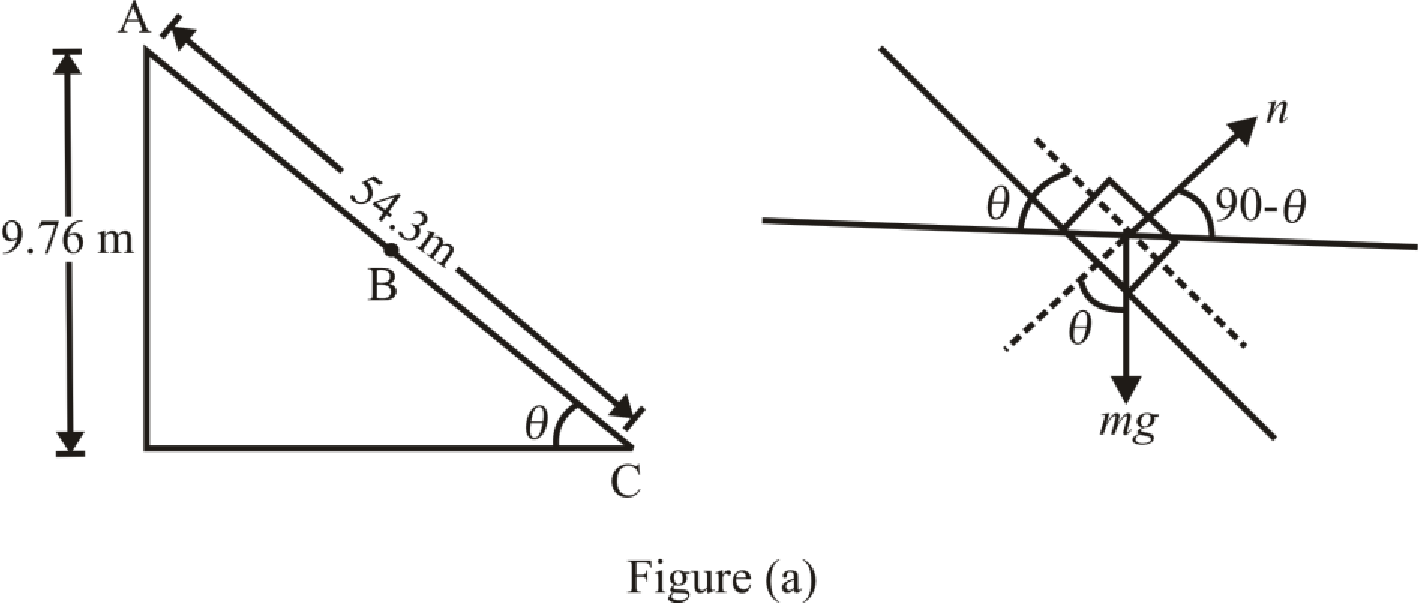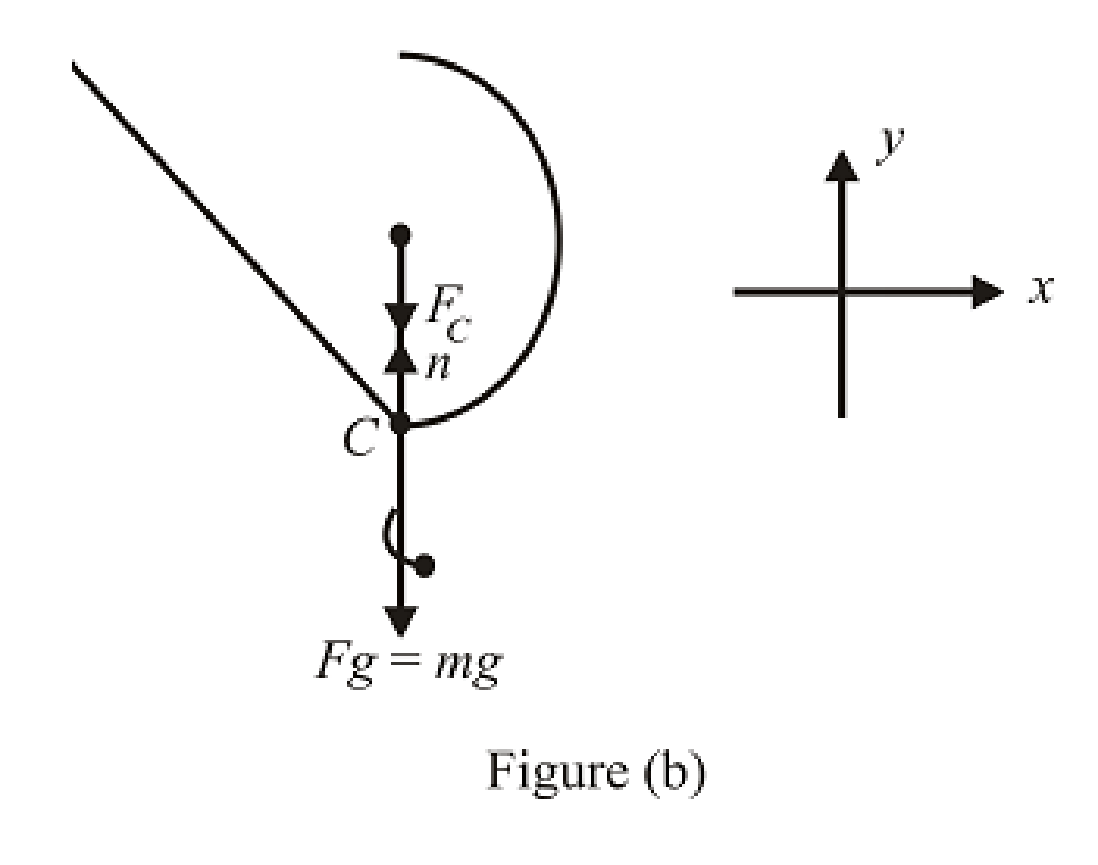
Concept explainers
(a)
The speed of the sled and rider at point C.
(a)
Answer to Problem 77AP
The speed of slader and rider at point C is
Explanation of Solution
Consider sled-chute-earth as an isolated system. Since, there is no friction force acting on the system.
Write the eqution for conservation of energy from point A to point C.
Write the equation for conservation of energy
Here,
Since, the system has potential energy due to gravitation of earth.
Write the equation for gravitational potential energy.
Here,
Write the expression for change in potential energy of the system.
Here,
Substitute
Simplify the above equation.
Here,
Since, the system has kinetic energy due to motion of sled and rider.
Write the equation for kinetic energy.
Here,
Write the expression for the change in kinetic energy.
Here,
Substitute
Simplify the above equation.
Here,
Substitute
Rearrange the above equation for
Conclusion:
Substitute
Thus, the speed of slader and rider at point C is
(b)
The magnitude of the total force the water exerts on the sled.
(b)
Answer to Problem 77AP
The magnitude of the total force the water exerts on the sled is
Explanation of Solution
Consider sled-water as a system.
Since, the friction force exerted by water is in retarding force and hence non-conservative force.
Write the equation for conservation of energy
Here,
Write the equation for work done by retarding force.
Here,
Substitute
Rearrange the above equation for
Simplify the above equation.
Since, the total force exerted by the water is friction force and normal force acting on the sled.
Write the equation for normal force
Here,
Write the expression for the magnitude of the total force
Here,
Since, the normal force and friction force are exerted in perpendicular direction.
Substitute
Simplify the above equation.
Conclusion:
Subsitute
Subsitute
Substitute
Thus, the magnitude of the total force the water exerts on the sled is
(c)
The magnitude of the force the chute exerts on the sled at point B.
(c)
Answer to Problem 77AP
The magnitude of the force the chute exerts on the sled at point B is
Explanation of Solution
Consider the sled on the chute at the point B as shown in figure (a).

Write the expression for the angle
Here,
Since, there is no motion in perpendicular direction fo the motion of sled, hence the net force at the point B will be zero.
Write the expression for net force in y-direction as shown in figure (I).
Here,
Conside the free body diagram of the sled and rider at point B.
Write the expression for net force.
Substitute
Rearrange the above equation for
Conclusion:
Substitute
Substitute
Thus, the magnitude of the force the chute exerts on the sled at point B is
(d)
The force exerted by the chute on the sled at point C where the chute is curving in the vertical plane.
(d)
Answer to Problem 77AP
The force exerted by the chute on the sled at point C where the chute is curving in the vertical plane is
Explanation of Solution
Consider the chute is curving in the vertical plane at point C.

The free body diagram of the sled at point C is as shown in figure (b).
Since, the sled has normal force and the centripital force is outward the center of curve.
Write the equation for net force at point C.
Here,
Substitute
Rearrange the above equation.
Conclusion:
Subsitute
Thus, the force exerted by the chute on the sled at point C where the chute is curving in the vertical plane is
Want to see more full solutions like this?
Chapter 8 Solutions
Physics for Scientists and Engineers with Modern, Revised Hybrid (with Enhanced WebAssign Printed Access Card for Physics, Multi-Term Courses)
- No chatgpt pls will upvotearrow_forwardthe cable may break and cause severe injury. cable is more likely to break as compared to the [1] ds, inclined at angles of 30° and 50° to the vertical rings by way of a scaled diagram. [4] I 30° T₁ 3cm 3.8T2 cm 200 N 50° at it is headed due North and its airspeed indicat 240 km/h. If there is a wind of 100 km/h from We e relative to the Earth? [3]arrow_forwardCan you explain this using nodal analysis With the nodes I have present And then show me how many KCL equations I need to write, I’m thinking 2 since we have 2 dependent sourcesarrow_forward
- The shear leg derrick is used to haul the 200-kg net of fish onto the dock as shown in. Assume the force in each leg acts along its axis. 5.6 m. 4 m- B Part A Determine the compressive force along leg AB. Express your answer to three significant figures and include the appropriate units. FAB = Value Submit Request Answer Part B Units ? Determine the compressive force along leg CB. Express your answer to three significant figures and include the appropriate units. FCB= Value Submit Request Answer Part C ? Units Determine the tension in the winch cable DB. Express your answer with the appropriate units. 2marrow_forwardPart A (Figure 1) shows a bucket suspended from a cable by means of a small pulley at C. If the bucket and its contents have a mass of 10 kg, determine the location of the pulley for equilibrium. The cable is 6 m long. Express your answer to three significant figures and include the appropriate units. Figure 4 m B НА x = Value Submit Request Answer Provide Feedback < 1 of 1 T 1 m Units ?arrow_forwardThe particle in is in equilibrium and F4 = 165 lb. Part A Determine the magnitude of F1. Express your answer in pounds to three significant figures. ΑΣΦ tvec F₁ = Submit Request Answer Part B Determine the magnitude of F2. Express your answer in pounds to three significant figures. ΑΣΦ It vec F2 = Submit Request Answer Part C Determine the magnitude of F3. Express your answer in pounds to three significant figures. ? ? lb lb F₂ 225 lb 135° 45° 30° -60°-arrow_forward
- The 10-lb weight is supported by the cord AC and roller and by the spring that has a stiffness of k = 10 lb/in. and an unstretched length of 12 in. as shown in. Part A Determine the distance d to maintain equilibrium. Express your answer in inches to three significant figures. 節 ΕΠΙ ΑΣΦ d = *k J vec 5 t 0 ? d C A in. 12 in. Barrow_forwardThe members of a truss are connected to the gusset plate as shown in . The forces are concurrent at point O. Take = 90° and T₁ = 7.5 kN. Part A Determine the magnitude of F for equilibrium. Express your answer to three significant figures and include the appropriate units. F = Value Submit Request Answer Part B 0 ? Units Determine the magnitude of T2 for equilibrium. Express your answer to three significant figures and include the appropriate units. ? T₂ = Value Units T₁ Carrow_forwardpls help on botharrow_forward
 Principles of Physics: A Calculus-Based TextPhysicsISBN:9781133104261Author:Raymond A. Serway, John W. JewettPublisher:Cengage Learning
Principles of Physics: A Calculus-Based TextPhysicsISBN:9781133104261Author:Raymond A. Serway, John W. JewettPublisher:Cengage Learning Physics for Scientists and Engineers: Foundations...PhysicsISBN:9781133939146Author:Katz, Debora M.Publisher:Cengage Learning
Physics for Scientists and Engineers: Foundations...PhysicsISBN:9781133939146Author:Katz, Debora M.Publisher:Cengage Learning Physics for Scientists and EngineersPhysicsISBN:9781337553278Author:Raymond A. Serway, John W. JewettPublisher:Cengage Learning
Physics for Scientists and EngineersPhysicsISBN:9781337553278Author:Raymond A. Serway, John W. JewettPublisher:Cengage Learning Physics for Scientists and Engineers with Modern ...PhysicsISBN:9781337553292Author:Raymond A. Serway, John W. JewettPublisher:Cengage Learning
Physics for Scientists and Engineers with Modern ...PhysicsISBN:9781337553292Author:Raymond A. Serway, John W. JewettPublisher:Cengage Learning University Physics Volume 1PhysicsISBN:9781938168277Author:William Moebs, Samuel J. Ling, Jeff SannyPublisher:OpenStax - Rice University
University Physics Volume 1PhysicsISBN:9781938168277Author:William Moebs, Samuel J. Ling, Jeff SannyPublisher:OpenStax - Rice University College PhysicsPhysicsISBN:9781285737027Author:Raymond A. Serway, Chris VuillePublisher:Cengage Learning
College PhysicsPhysicsISBN:9781285737027Author:Raymond A. Serway, Chris VuillePublisher:Cengage Learning





